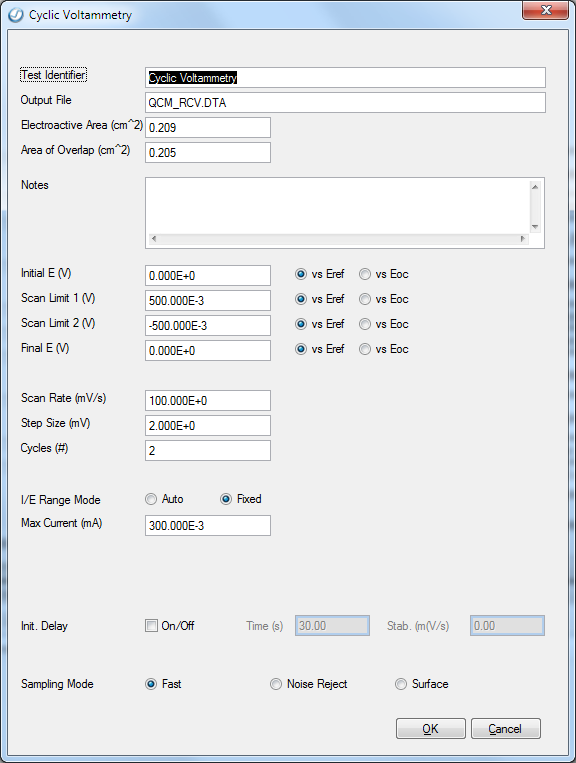

|
See Test Identifier in the Common Potentiostat Setup Parameters section. |
|
|
See Output File in the Common Potentiostat Setup Parameters section. |
|
|
See Electroactive Area in the Common Potentiostat Setup Parameters section. |
|
|
See Area of Overlap in the Common Potentiostat Setup Parameters section. |
|
|
See Notes in the Common Potentiostat Setup Parameters section. |
|
|
The starting potential of the scan segment. This potential can be selected in a versus Eoc or versus Eref. Units are volts. |
|
|
The first apex potential in a cyclic voltammetry scan. This potential can be selected in a versus Eoc or versus Eref. Units are volts. |
|
|
The second apex potential in a cyclic voltammetry scan. This potential can be selected in a versus Eoc or versus Eref. Units are volts. |
|
|
The ending potential of the scan segment. This potential can be selected in a versus Eoc or versus Eref. Units are volts. |
|
|
The Scan Rate parameter defines the speed of the potential sweep during data acquisition. Units are mV/s. A practical bound on the Scan Rate is 1000 mV/s. Higher scan rates may run, but can yield inaccurate data because software cannot acquire data points fast enough. Scan Rate, when combined with the Step Size parameter, determines time between data points and thus the data-acquisition rate used in the experiment. Time (seconds/point) = [Step Size (mV/point)] / [Scan Rate (mV/second)] The maximum data-acquisition rate depends on the speed of the computer and the configuration of Windows® and the other software currently executing. As a guideline, avoid sample times below 100 μs. NOTE: For scans faster than 1 ms, the acquired data are displayed once the experiment has completed. This reduces the chance that the computer will limit the acquisition speed. |
|
|
The Step Size parameter determines the spacing between the data points in mV. A typical Step Size setting is between 1 and 5 mV. The Step Size parameter combines with the scan range on any given cycle to determine the number of data points. # Points = [Scan Range (mV)] / [Step Size (mV)] The total number of data points must be less than 64000 for all cycles. The Step Size parameter also combines with the Scan Rate parameter to determine the time interval between the data points. |
|
|
Controls the number of times the potential scan repeats during the experiment. Conceptually it is the number of times the potential cycles from the Initial E setting to Scan Limit 1 to Scan Limit 2 to the Final E setting. |
|
|
See I/E Range Mode in theCommon Potentiostat Setup Parameters section. |
|
| Init. Delay |
See Init. Delay in the Common Potentiostat Setup Parameters section. |
|
See Max Current in the Common Potentiostat Setup Parameters section. |
|
|
Defines whether or not the potentiostat oversamples and averages during acquisition. These options are only relevant on the Reference™ family instruments. |